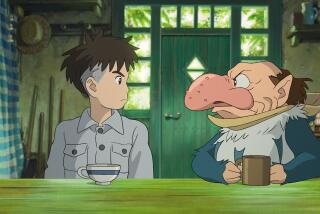The therapy of moviemaking
- Share via
During the four years it took to make the Israeli-animated documentary “Waltz With Bashir,” writer-director-producer Ari Folman never had time to consider whether his uniquely stylized film would play outside his country.
“When we completed the film, we were totally clueless about how far it would go,” admits Folman. “We were -- especially me -- pretty much obsessed with just completing it.”
Produced on a lean budget of $1.5 million, “Waltz With Bashir,” which opened Christmas Day, was accomplished by just eight animators -- two were brought on near the end of the project -- and four illustrators, with David Polonsky doing 80% of the designs.
“It is the second-ever animated feature in Israel,” says Folman. “The first was a stop-motion film in 1961. So there is no tradition in animation [in Israel], which is good sometimes because you don’t have to follow anything. You have more freedom.”
Since its enthusiastic reception at the Cannes Film Festival in May, “Waltz With Bashir” has landed on many top 10 lists and won several accolades, including six awards from the Israeli Film Academy, one being best picture; foreign-language film at the British Independent Film Awards and animated film from the Los Angeles Film Critics’ Assn. It’s also nominated for a Golden Globe for foreign-language film.
“In my sweetest dreams, I didn’t think that the film would go so far,” says Folman, who has written for the Israeli version of “In Treatment” and is an award-winning TV documentarian. He had previously dipped his toe into animated documentary with his series “The Material That Love Is Made Of”; each episode opened with five minutes of documentary animation.
But in 1982, he was a 19-year-old soldier in the Israel Defense Forces. Over the years, he had blocked out his experiences from the Lebanon War, especially the Sabra and Shatila refugee camp massacres led by the Phalangists Christian militia in Lebanon.
“Blocking out and suppressing is maybe not a bad method to survive -- to go on with your life,” Folman says.
But he was haunted by a recurring nightmare in which he encountered crying women in black chadors while walking down the street.
At age 40, he requested an early release from the Israeli reserve army. The military said it would grant it “if I would go to a therapist and tell him what I went through. That’s how [the memories] started to get out. That is the first time for me to hear my own story.”
The easy part was making the decision to do the documentary. The hard part was coming to grips with what happened in 1982.
“The major problem is to realize that there is a lot there you haven’t done anything with,” he says. “There is no way back once you start the process.”
Folman made “Waltz With Bashir” first as a 90-minute video featuring interviews of his friends and soldiers also beset with nightmares and problems remembering that time.
He always envisioned “Waltz With Bashir” as an animated film, especially because it focuses on dreams, fantasy and loss of memory. “Animation gave me the freedom to do it,” he says.
Once Folman completed editing the video version of “Bashir,” he, Polonsky and director of animation Yoni Goodman broke it into storyboards.
“We decided this [scene] was going to be a talking head,” says Goodman, whose animation background includes video and short films. “This is going to be a re-creation and this is going to be a fantasy. . . . Ari had very rough ideas of what he wanted. He was very open to suggestions.”
Though some of the animation resembles Richard Linklater’s 2006 film “A Scanner Darkly,” Folman and Goodman say it wasn’t done in the same method, in which animators trace over live-action footage.
“The film was done in mainly Flash animation, which is 2-D software,” says Goodman. “We had to develop a system that would work for us where we would get a very high-quality look for the animation. We couldn’t do a fully traditional animated feature because that would take 200 or 300 people, so we had to find a system that worked for us.”
“You can’t do a $1.5-million film and pretend you’re Pixar, you know,” adds Folman. “Basically, we took software that was made for home [computers] to the most extreme levels and made the film.”
--
More to Read
Only good movies
Get the Indie Focus newsletter, Mark Olsen's weekly guide to the world of cinema.
You may occasionally receive promotional content from the Los Angeles Times.











